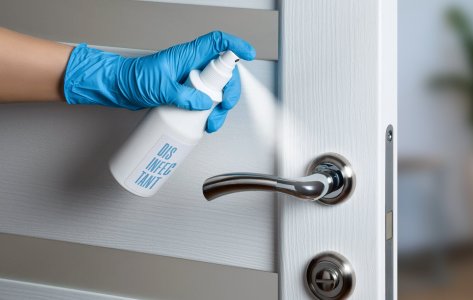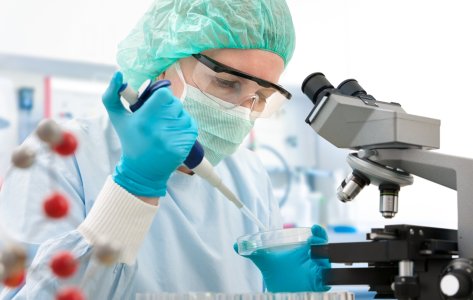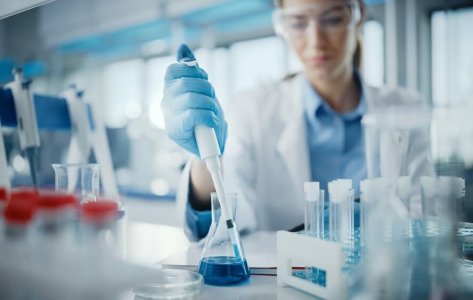- Swiss testing laboratory
BS EN 16438: 2014

Hassle-free testing experience
Need to get a product tested? No worries! To and fro logistics are on us; we collect your products, test them and, deliver them back to you.
Related tests for you
Quick understanding of the test
BS EN 16438: 2014 - Quantitative surface test for the evaluation of fungicidal or yeasticidal activity of chemical disinfectants and antiseptics used in the veterinary area on non-porous surfaces without mechanical action (phase 2, step 2)
EN 16438 is a phase 2, step 2, carrier test to assess the fungicidal or yeasticidal activity of disinfectants and antiseptics used in veterinary areas on non-porous surfaces, under real-world conditions.
Application
- Candida albicans (ATCC 10231)
- Aspergillus niger (ATCC 16404)
- Microbial suspension with interfering substance is inoculated onto a metal disc surface (carrier) and allowed to dry.
- The disinfectant sample is spread onto a dried inoculated carrier for a specified contact time.
- At the end of contact time, the carrier is neutralized.
- Neutralized extract is plated and enumerated to recover viable microorganisms.
- EN 16438 simulates actual conditions on non-porous surfaces, making results directly applicable to practical use.
- Helps manufacturers meet European regulatory standards for veterinary disinfectants, ensuring market access.
Turnaround Time
Passing criteria
Do you have a product that needs testing?
Abstract
EN 16438 is a Phase 2, Step 2 quantitative carrier test that evaluates the fungicidal and yeasticidal efficacy of chemical disinfectants and antiseptics on non‑porous surfaces in the veterinary settings. As a Phase 2, Step 2 method, EN 16438 employs stainless steel discs (carriers) that closely mimic real-world surfaces, ensuring the test accurately reflects practical performance. The standard also includes challenging conditions like low and high organic soiling to ensure disinfectant reliability.
The standard specifies the use of conidiospores of Aspergillus brasiliensis (formerly A. niger) together with vegetative cells of Candida albicans to assess fungicidal activity, and only the vegetative cells of C. albicans for testing yeasticidal activity.
Scope of Products
The test is applicable to disinfectant products used in the disinfection of veterinary settings like:
- Animal husbandry
- Breeding
- Production
- Transport
- and disposal of all animals (excluding when in food chain following death and entry to the processing industry)
EN 16438 Test Conditions & Requirements
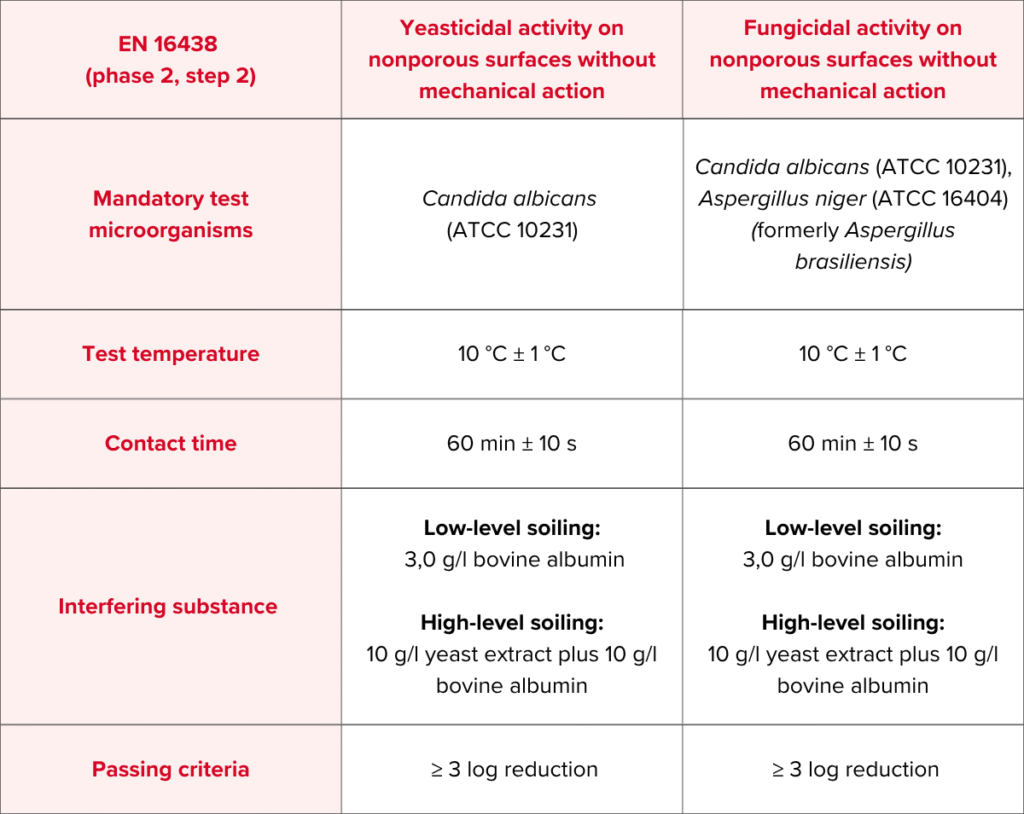
EN 16438 Test Method
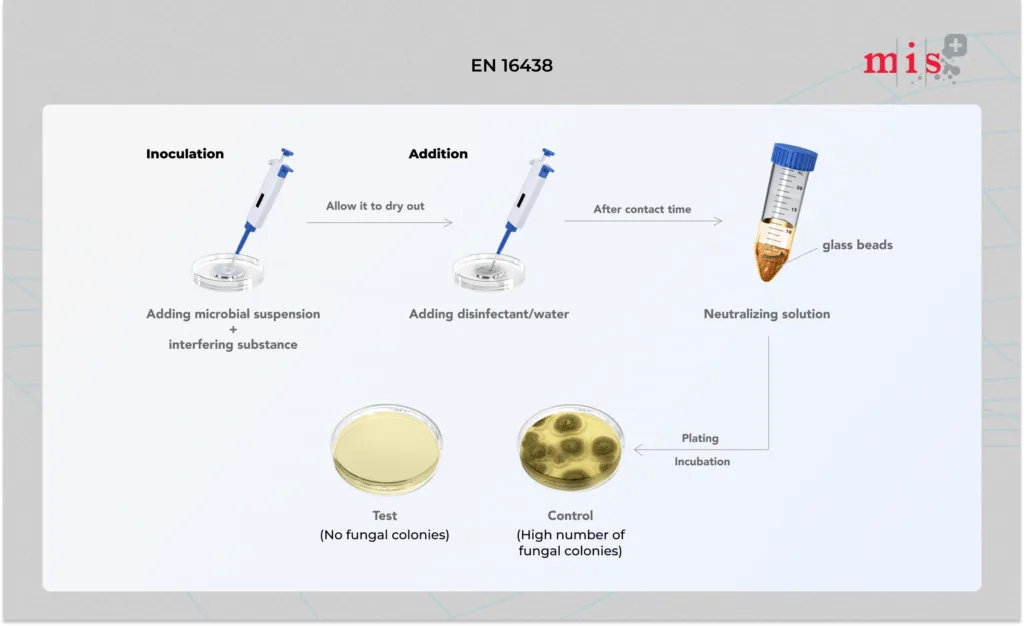
- A test suspension of microorganisms with interfering substance is inoculated onto a metal disc surface (carrier) and allowed to dry.
- Test product is evenly spread over the dried culture of test microbes. The carrier surface with the test product is kept for a recommended contact period and temperature.
- At the end of contact time, the carrier is immersed in a solution to neutralize fungicidal/yeasticidal action of the test product.
- The number of recovered microorganisms in neutralizing solution is enumerated using plate count technique.
- Results are concluded by comparing the number of viable microorganisms examined on treated surface with microbial count from surface treated with water (instead of disinfectant).
Passing criteria
A minimum of ≥ 3 log reduction in the test microorganisms is required to pass the test.
Importance of EN 16438 Test
In veterinary settings, fungal and yeast persistence on inanimate surfaces can make veterinarians, staff, and even animals more susceptible to infection. Therefore, disinfection is a crucial practice to ensure sanitation and infection control.
As per European norms, veterinary disinfectants claiming fungicidal or yeasticidal must be tested for their efficacy under standardized methods. EN 16438 standard is established to check microbicidal activity of product samples against Candida albicans and Aspergillus niger under conditions mimicking situations for their respective area of application.
Conclusion
At MIS, we provide both customized and standardized efficacy testing solutions that come within the scope of EN 16438 standard.
In our state-of-the-art testing facilities, microbiological analysis is undertaken by our highly skilled staff with extensive experience in microbiome research, classical microbiology techniques, methodology, and technical analysis.
Additionally, clients can also send their test samples for EN 1650 testing in our labs.
To request a quote for EN 16438 or want to know more about our services, contact our experts today.
Frequently Asked Questions

DR. Martinoz Scholtz
EN 16438 is a quantitative non-porous surface test for chemical disinfectants and antiseptics used in veterinary areas without mechanical test. To pass EN 16438, test product must show at least 3 log reductions for reference microorganisms as a minimum measure of efficacy.
EN 16438 test is applicable to chemical disinfectants and antiseptics that are designed to be used for disinfection of non-porous surfaces in veterinary settings.
EN 16438 test takes 2-3 weeks to complete.
At Microbe Investigations Switzerland, we test for EN 16438 using the following microbial strains: Candida albicans (MTCC 3017) and Aspergillus niger (ATCC-16888). However, other test organisms can also be used as per the client’s request.
Meet the best of the blend of
R&D, Efficacy Testing,
Innovation and Passionate
Experts at MIS.





Explore More
Did you know there are
Antibacterial testing of disinfectants plays
Antimicrobial testing is important to
Understanding EN 1040 standard is

